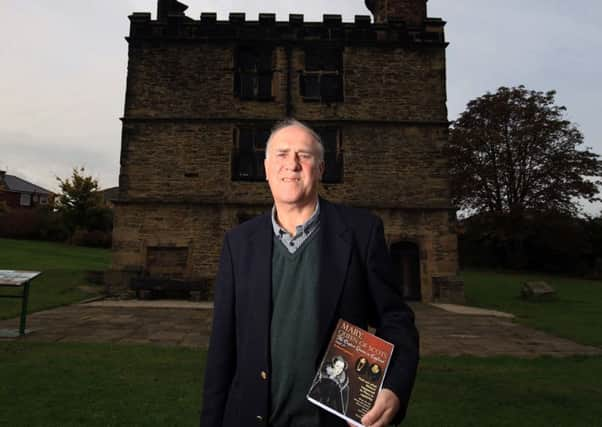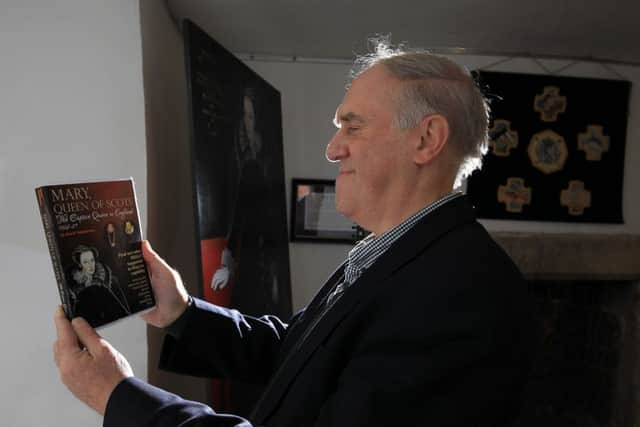The Star Interview with Richard Blackledge: Putting Sheffield back into the history books


Historian David Templeman is leading us up to the room in the Turret House at Manor Lodge which brings to life the 14 years Mary, Queen of Scots spent in captivity in Sheffield.
Small model birds are hung in the small window, inspired by the avian pets Mary kept to pass the time, replica pieces of needlework inspired by her favoured hobby are displayed on the walls and, in the corner, there’s a painting of the prisoner herself, looking pale and drawn.


Advertisement
Hide AdAdvertisement
Hide Ad“This is a major piece of English and European history, this site, there’s no two ways about it,” says David.
“She spent 19 years of her 44 years in captivity. There’s one chapter in the biographies, that’s all you’ll find. That’s why my book had to be written.”
David’s newly-published first - and, he claims, last - book, aims to give the most detailed account yet of the years Mary was kept confined in England by her cousin, Queen Elizabeth I.
Mary fled from Scotland in 1568 after abdicating from the throne there. But instead of receiving help from Elizabeth, she was perceived as a threat, and for the remaining 18 years of her life was held at several manor houses and castles around England, including Chatsworth, Sheffield Castle and Sheffield Manor, then an imposing property which now lies mostly in ruins.


Advertisement
Hide AdAdvertisement
Hide Ad“It might come over that I’m in support of her, but I’m just trying to put across that she did have a tough time in captivity,” David explains.
“She came here for help - she shouldn’t have been imprisoned here.
“But if you put yourself in Elizabeth’s shoes, she had one opportunity of keeping her here. If she let her go she could have gone back to France and Spain, which were more powerful than England at the time.
“In all likelihood she could have raised an army to take the Scottish throne and, while they were at it, they might as well have taken the English throne off Elizabeth.
Advertisement
Hide AdAdvertisement
Hide Ad“Think about what she could have risked by letting her go. You can’t put 21st century values on all this.”
The road to the book started in Attercliffe, where the writer was brought up. Each weekend his parents would take David and his brother to a different historical site.
“We went all over the place, I was steeped in history right from the word go.
“The place I really centred on was one of Mary Queen of Scots’ prisons - Wingfield Manor near Alfreton. My grandmother lived at a place called Pinxton in Nottinghamshire, we used to go there every Sunday and you would go past it, standing on the hill.”
Advertisement
Hide AdAdvertisement
Hide AdDavid excelled in history at Woodhouse Grammar, and his teacher in the subject encouraged him to ‘do something’ with his talent in the field.
“But I was into sport, and I knew he was trying to push me into teaching, which I had no interest in at all.
“But funnily enough, now I’ve retired I’ve done lectures throughout the country, I’m a national speaker. So it’s turned around from what he said at 16 right through to when I’m 61!
“I keep thinking he’d be proud of me, if he could see me.”
David, who now lives in Dronfield, worked as an area manager for Whitbread’s brewery, and later managed betting offices before retiring in 2004.
Advertisement
Hide AdAdvertisement
Hide AdBy then he had already begun volunteering at Manor Lodge - he and his wife Anne set up a new Friends group when the old one disbanded, and in the same year as his retirement the site featured on the BBC television series Restoration.
Since then the lodge, managed by Green Estate on behalf of the council, has been developed with more than £2 million in Heritage Lottery funding, including the opening of a Discovery Centre for visitors.
“When I came here there was nothing,” David reflects.
“We were just given the keys, the Friends group, opened the gates and took people in one Sunday every month. We kept it going.
“So many people still don’t know what’s up here.”
Supporters collect up to £6,000 a year for the attraction, through fundraisers including four annual speaking events. Prominent historians such as David Starkey, a patron of the lodge, give talks, many waiving their fee.
Advertisement
Hide AdAdvertisement
Hide AdAmassing the research for the book took 11 years. Long periods were spent trawling the Chatsworth and Sheffield archives, and poring over Mary’s letters online.
“That’s been the beauty of waiting, because this access has only come in the last few years,” says David.
“All the information I wanted was available, so I thought - let’s do it.
“It’s never been done like this before, not a modern-day version. Hopefully this will be accepted as the definitive version.”
Advertisement
Hide AdAdvertisement
Hide AdIt’s every historian’s ambition to shed fresh light on a particular era, and David thinks he’s fulfilled the brief.
“There’s lots of stuff in there you can’t find anywhere else. This will be my one and only book.”
n ‘Mary, Queen of Scots, the Captive Queen in England 1568-87’ will be launched on Saturday, November 5 at an event sponsored by The Star as part of the Off The Shelf literary festival. There will be bagpipe music, an illustrated talk and theatrical re-enactments. Books will be on sale priced £9.99, proceeds to the Friends of Manor Lodge. The launch, at the Central United Reformed Church on Norfolk Street in the city centre, starts at 2pm, tickets £6, £5 concessions. To book call 0114 223 3777.
Sheffield at the centre of Elizabethan drama
Sheffield was ‘the main player’ in the life of Mary, Queen of Scots, believes David Templeman.
Advertisement
Hide AdAdvertisement
Hide Ad“We worked out that she spent more time in Sheffield Castle than in any other residence in her lifetime,” he says.
“Not that she wanted to - but it’s a fact. You can’t hide it.”
He adds: “There were escape attempts here, there were plots sprung on the throne of England. All here when she was in Sheffield.
“And if she’d have escaped and took the throne off Elizabeth, the whole course of English history would have to be rewritten.
Advertisement
Hide AdAdvertisement
Hide Ad“We would have been Catholic, we would have had Spanish troops here, you would have had a civil war between Protestants and Catholics - people don’t realise it was a very finely-balanced thing.”
The book helps to redress the balance set by previous accounts of her life, he asserts.
“I thought, at some stage, somebody’s got to sit down and write a proper book of the 19 years in captivity, and really get it right, and get Sheffield back in, because Sheffield usually gets three or four mentions.”